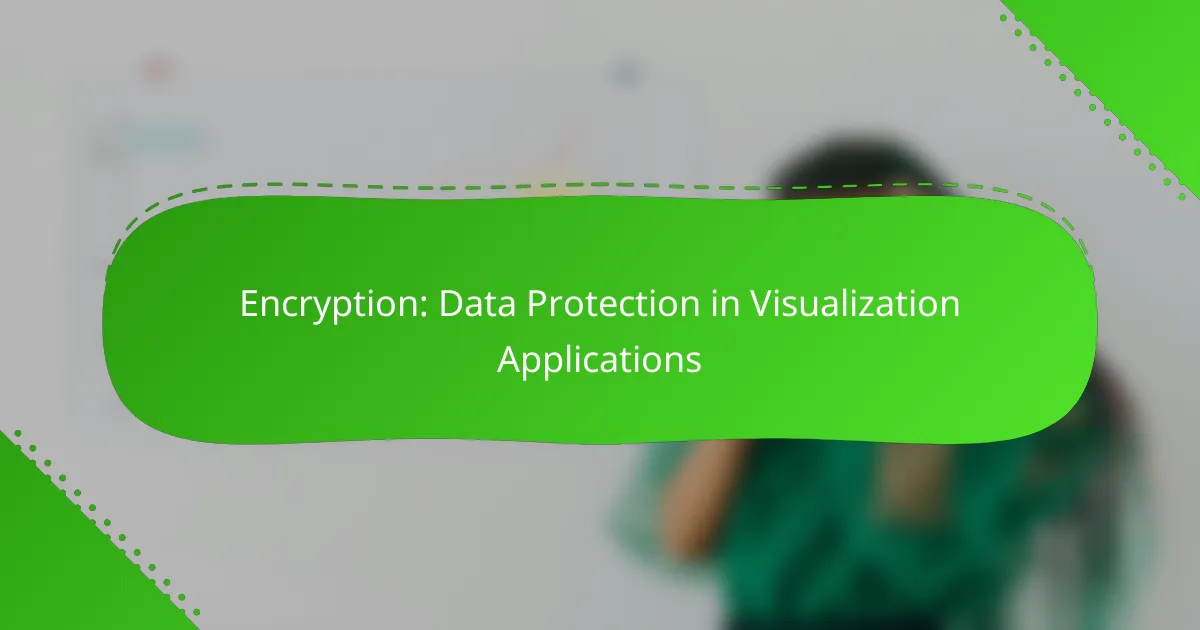In the realm of visualization applications, encryption plays a crucial role in safeguarding sensitive data from unauthorized access. Utilizing methods such as AES, RSA, and SSL/TLS, these tools ensure that data remains confidential during both storage and transmission. Compliance with data protection regulations further emphasizes the importance of implementing robust encryption strategies to maintain privacy and security.
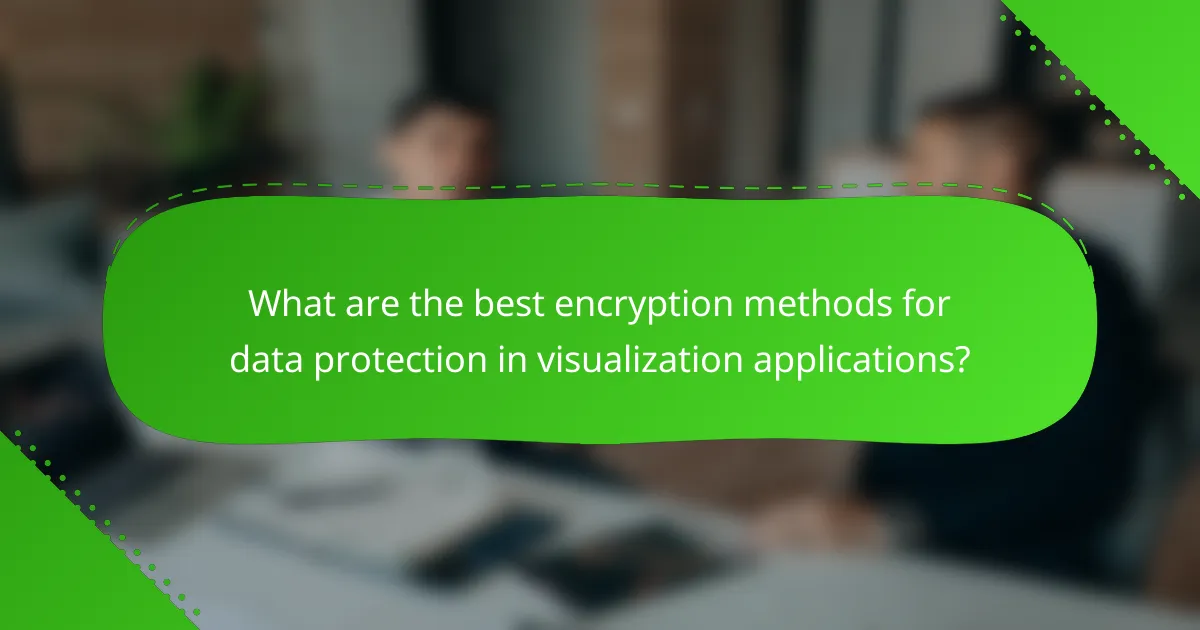
What are the best encryption methods for data protection in visualization applications?
The best encryption methods for data protection in visualization applications include AES, RSA, SSL/TLS, end-to-end encryption, and homomorphic encryption. Each method offers unique advantages and considerations, making them suitable for different use cases in securing sensitive data.
AES (Advanced Encryption Standard)
AES is a symmetric encryption algorithm widely used for securing data in visualization applications. It operates on fixed block sizes and supports key lengths of 128, 192, or 256 bits, providing a strong level of security. AES is efficient and fast, making it suitable for real-time data protection.
When implementing AES, ensure that keys are managed securely and consider using modes like GCM or CBC for additional security features. Avoid using outdated or weak key lengths to maintain robust protection.
RSA (Rivest-Shamir-Adleman)
RSA is an asymmetric encryption method that uses a pair of keys: a public key for encryption and a private key for decryption. This method is particularly useful for securely exchanging keys used in symmetric encryption, such as AES. RSA is widely adopted for secure communications, including data visualization applications.
While RSA provides strong security, its performance can be slower compared to symmetric methods. It is advisable to use RSA for key exchange rather than for encrypting large datasets directly due to its computational intensity.
SSL/TLS (Secure Sockets Layer/Transport Layer Security)
SSL and its successor TLS are protocols designed to secure communications over a network. They encrypt data in transit, protecting it from eavesdropping and tampering, which is crucial for visualization applications that transmit sensitive information. SSL/TLS is commonly used in web applications and APIs.
To implement SSL/TLS effectively, ensure that you use up-to-date versions and strong cipher suites. Regularly update certificates and monitor for vulnerabilities to maintain a secure environment.
End-to-End Encryption
End-to-end encryption (E2EE) ensures that data is encrypted on the sender’s device and only decrypted on the recipient’s device, preventing unauthorized access during transmission. This method is particularly effective in protecting sensitive data in visualization applications where privacy is paramount.
When using E2EE, choose platforms that implement strong encryption standards and provide user-friendly key management. Be aware that while E2EE enhances security, it may complicate data recovery and sharing processes.
Homomorphic Encryption
Homomorphic encryption allows computations to be performed on encrypted data without needing to decrypt it first. This method is advantageous for visualization applications that require data analysis while maintaining confidentiality. It enables secure processing of sensitive data without exposing it to potential breaches.
However, homomorphic encryption can be computationally intensive and may introduce latency. Evaluate the trade-offs between security and performance based on your specific application needs before implementation.
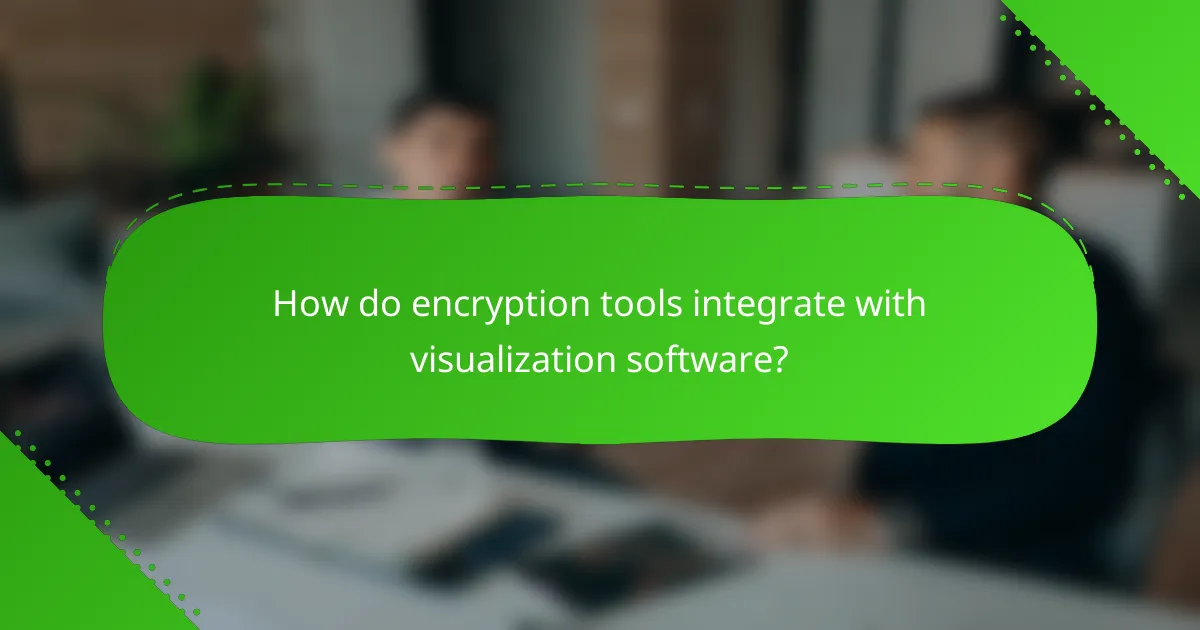
How do encryption tools integrate with visualization software?
Encryption tools enhance the security of visualization software by protecting sensitive data during storage and transmission. This integration ensures that visualized data remains confidential and compliant with data protection regulations.
Integration with Tableau
Tableau supports encryption through its built-in capabilities and external tools. Users can enable encryption for data at rest and in transit, ensuring that sensitive information is protected while being visualized. Tableau’s integration with encryption tools like AWS KMS allows for seamless management of encryption keys.
When implementing encryption in Tableau, consider the data sources being used and the specific encryption standards required by your organization. Regularly review and update encryption protocols to align with best practices and compliance requirements.
Integration with Power BI
Power BI offers robust encryption features that secure data both at rest and in transit. By utilizing Azure’s encryption services, users can ensure that their data remains protected while being processed and visualized. Power BI also allows for the integration of third-party encryption tools to enhance security measures.
To effectively use encryption in Power BI, ensure that your data gateways are configured to use secure connections. Additionally, regularly audit access permissions to maintain control over sensitive data and prevent unauthorized access.
Integration with Qlik Sense
Qlik Sense integrates encryption capabilities to safeguard data throughout its lifecycle. The platform supports encryption for data at rest using various algorithms and allows users to encrypt data in transit through secure connection protocols. This ensures that visualizations are safe from potential breaches.
For optimal encryption in Qlik Sense, utilize the built-in security rules to manage user access and data visibility. Regularly update your encryption methods to comply with evolving security standards and protect against emerging threats.
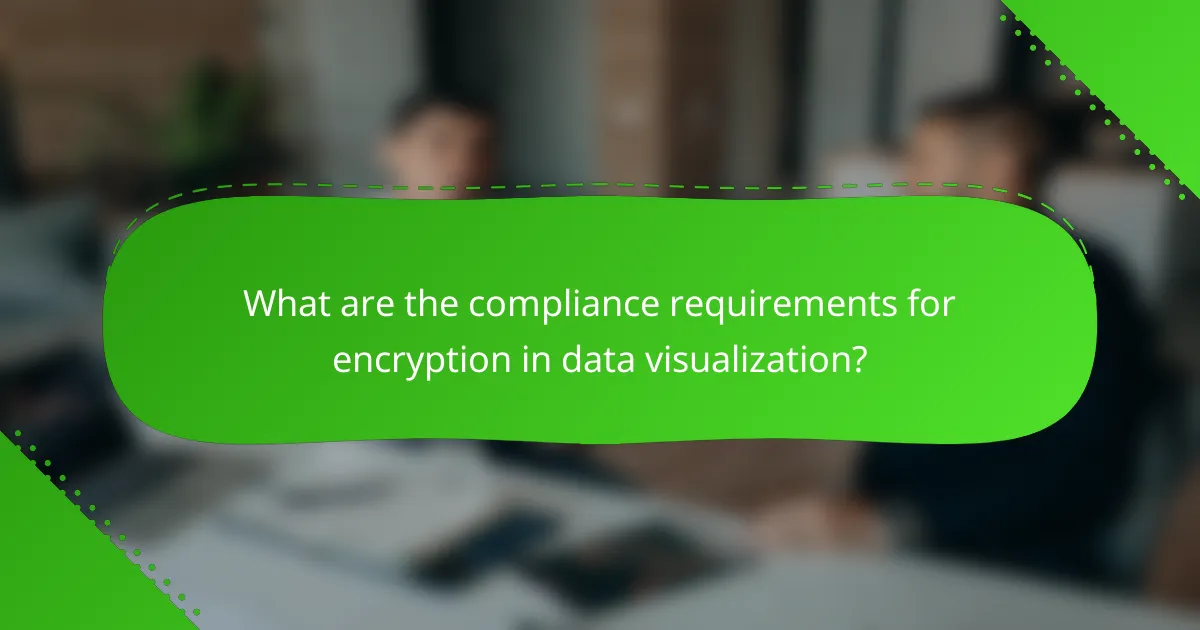
What are the compliance requirements for encryption in data visualization?
Compliance requirements for encryption in data visualization focus on protecting sensitive data from unauthorized access. Organizations must adhere to specific regulations that dictate how data should be encrypted, stored, and transmitted to ensure privacy and security.
GDPR (General Data Protection Regulation)
The GDPR mandates that personal data must be processed securely, which includes the use of encryption. Organizations that handle data of EU citizens must implement encryption to protect data at rest and in transit, minimizing the risk of data breaches.
To comply, businesses should assess the types of data they collect and implement encryption protocols that meet GDPR standards. Regular audits and updates to encryption methods are essential to maintain compliance and protect user data effectively.
HIPAA (Health Insurance Portability and Accountability Act)
HIPAA requires healthcare organizations to safeguard patient information through encryption, especially when transmitting electronic health records. Encryption is considered an addressable implementation specification, meaning that while it is not mandatory, it is strongly recommended to protect sensitive health information.
Organizations should evaluate their encryption strategies and ensure that any data shared over networks is encrypted. Failure to comply can result in significant fines and loss of trust from patients.
CCPA (California Consumer Privacy Act)
The CCPA emphasizes the protection of personal data for California residents, and while it does not explicitly mandate encryption, it encourages businesses to implement reasonable security measures, including encryption, to protect consumer data. Compliance with CCPA can enhance customer trust and reduce the risk of data breaches.
Companies should consider encrypting personal data to meet CCPA guidelines and avoid penalties. Regularly reviewing data protection practices and ensuring encryption is part of the overall data security strategy is advisable.
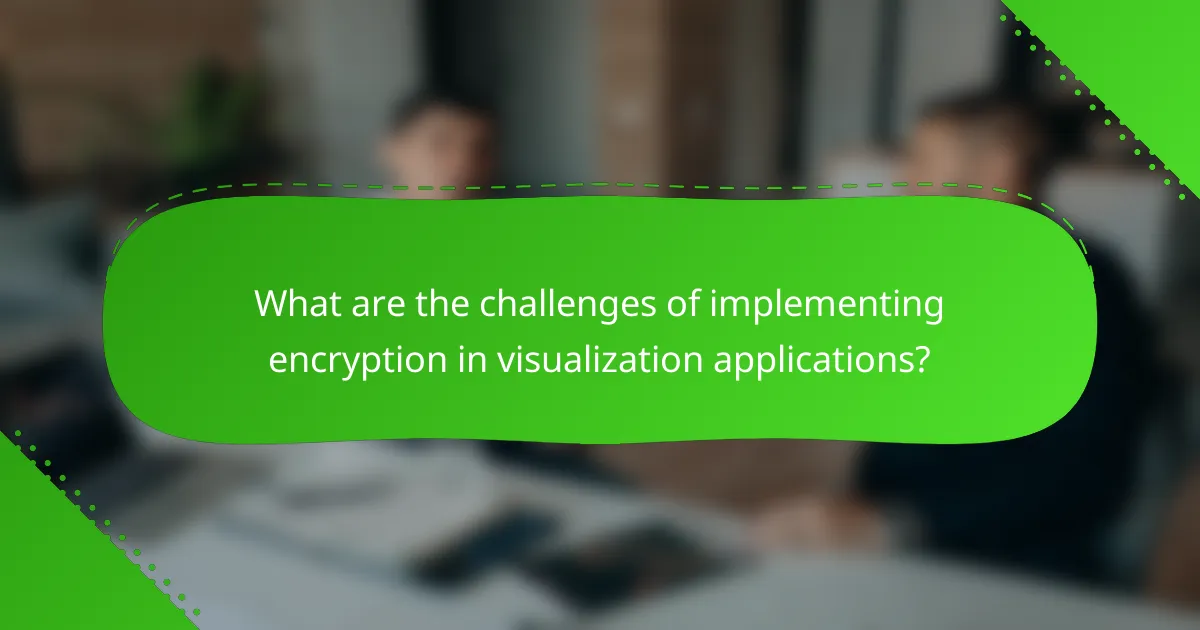
What are the challenges of implementing encryption in visualization applications?
Implementing encryption in visualization applications presents several challenges, including performance impact, user accessibility, and key management. These factors can significantly affect the overall user experience and the effectiveness of data protection strategies.
Performance Impact
Encryption can slow down data processing and rendering times in visualization applications. This is particularly critical when dealing with large datasets, where the overhead of encrypting and decrypting data can lead to noticeable delays.
To mitigate performance issues, consider using lightweight encryption algorithms or optimizing data handling processes. For example, applying encryption selectively to sensitive data rather than the entire dataset can help maintain responsiveness.
User Accessibility
Encryption can complicate user access to data visualizations, especially if users require specific permissions or credentials to view encrypted content. This can create barriers for legitimate users who may struggle with authentication processes.
To enhance accessibility, implement user-friendly authentication methods, such as single sign-on (SSO) or token-based access. Additionally, ensure that users are adequately trained on how to navigate any security measures in place.
Key Management
Effective key management is crucial for maintaining the security of encrypted data in visualization applications. Poor key management practices can lead to unauthorized access or data loss if keys are compromised or lost.
Establish a robust key management policy that includes regular key rotation, secure storage solutions, and clear protocols for key access. Utilizing established standards, such as those from the National Institute of Standards and Technology (NIST), can provide a solid framework for managing encryption keys effectively.
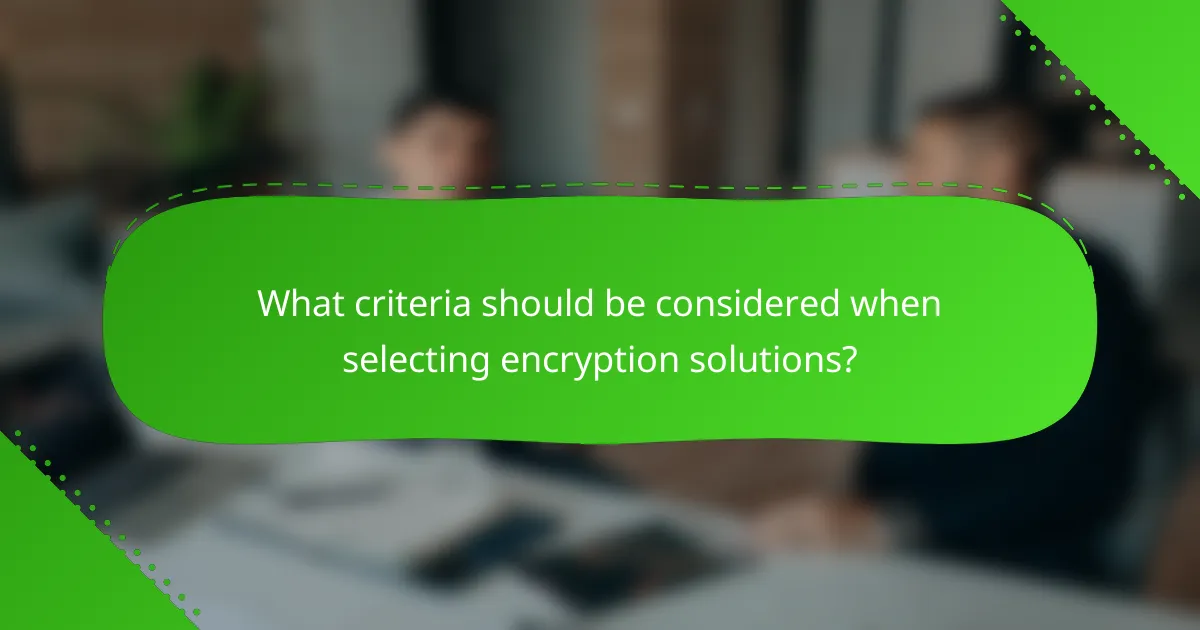
What criteria should be considered when selecting encryption solutions?
When selecting encryption solutions, consider factors such as scalability, ease of use, and compliance with relevant regulations. These criteria ensure that the solution can grow with your needs while remaining user-friendly and legally compliant.
Scalability
Scalability refers to the ability of an encryption solution to handle increasing amounts of data or users without compromising performance. Look for solutions that can efficiently manage growth, whether that means accommodating larger datasets or more simultaneous users.
For instance, cloud-based encryption services often offer scalable options that allow you to adjust your usage based on demand. This flexibility can be crucial for organizations that anticipate fluctuations in data volume or user activity.
Ease of Use
Ease of use is essential for ensuring that all team members can effectively implement and manage encryption without extensive training. A user-friendly interface and straightforward setup process can significantly reduce the time and resources needed for deployment.
Consider solutions that provide clear documentation and support. Additionally, features like automated key management can simplify operations, allowing users to focus on their core tasks rather than the complexities of encryption.
